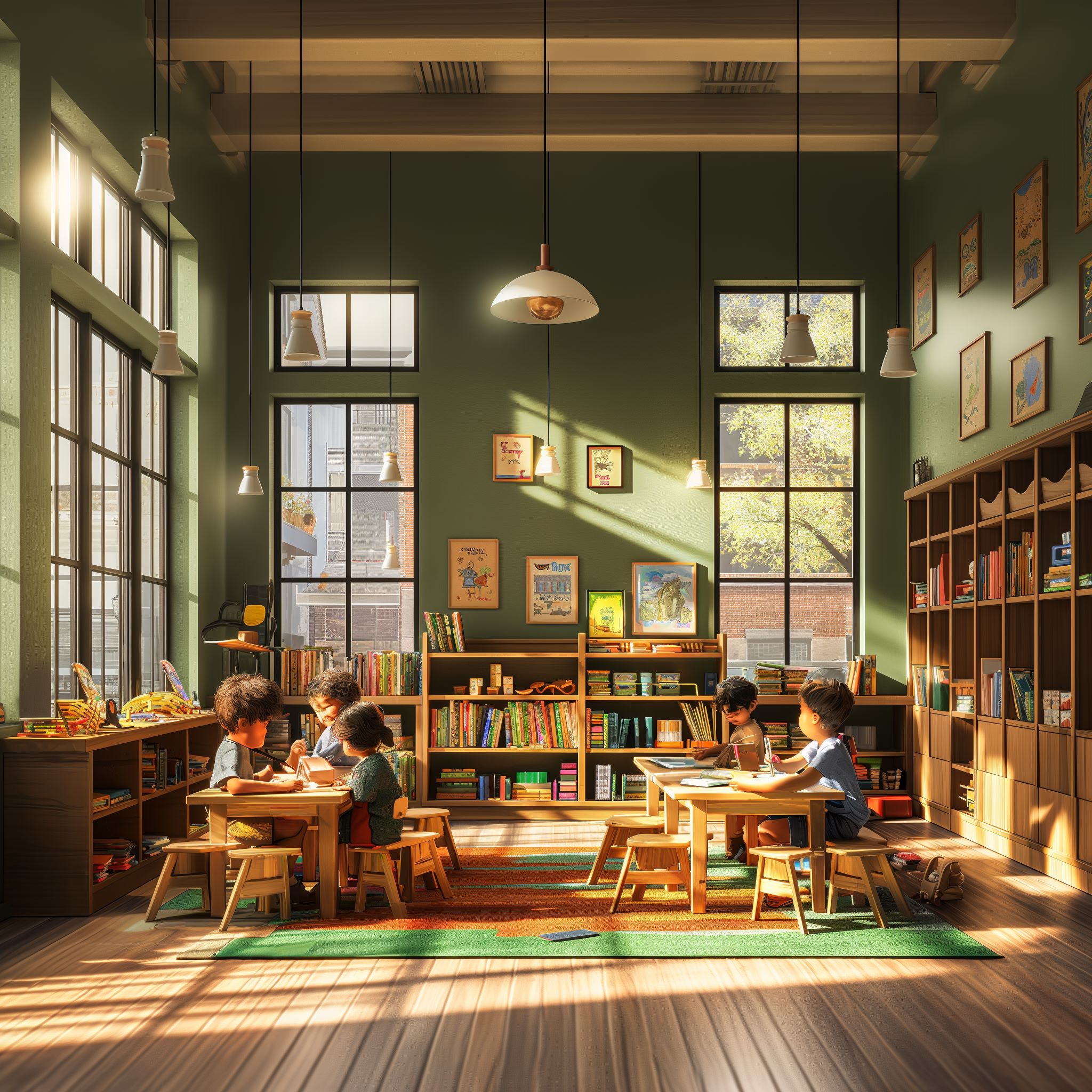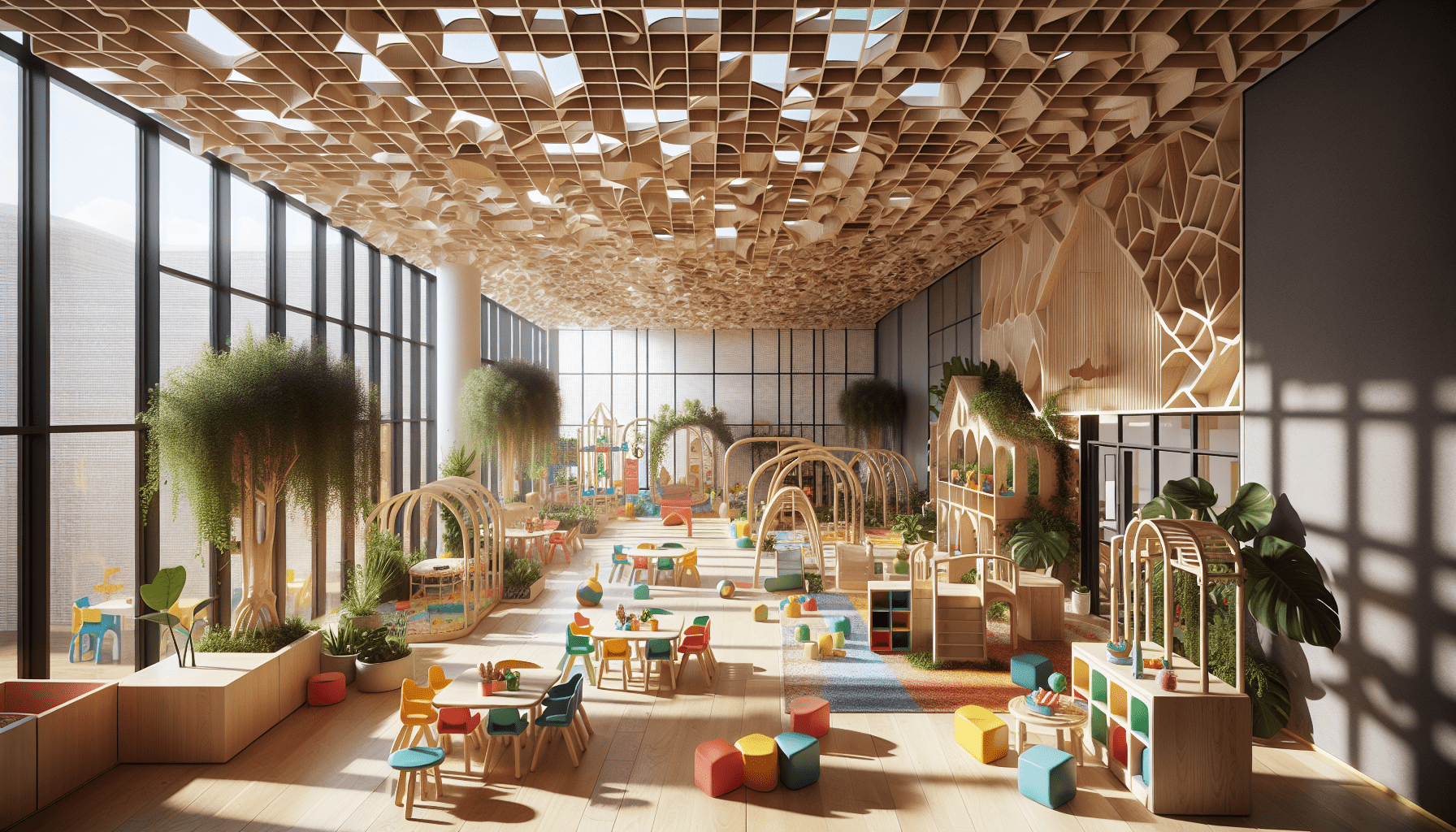Imagine walking into an empty room, the walls bare, the floors unscuffed, and the air filled with possibility. It’s a rare moment of calm before the inevitable whirlwind of crayons, storybooks, and tiny handprints takes over. But in that brief stillness, you have a chance—a chance to shape a space that will do more than just hold the chaos. It can actually influence the minds and moods of the children who enter.
One of the most powerful tools at your disposal? Color. It’s more than just a visual choice; it’s a subtle architect of emotion and focus. Take blue, for instance. Sure, we talk about feeling blue, but think of the serenity of a clear sky or the endless depth of the ocean. Blue has a way of calming the mind and encouraging focus, making it a perfect backdrop for learning.
Then there’s green, the color of spring, growth, and renewal. It’s the shade we yearn for after a long winter, the signal that life is bursting forth once more. In a learning environment, green echoes these themes of health and vitality, nurturing a sense of well-being and progress.
Yellow, on the other hand, is like the sun bottled up. It’s warm, energetic, and bright—the kind of color that can make a room feel alive. But it’s also versatile. A bold yellow can charge up an active space, while a softer hue offers comfort and reassurance, wrapping the room in a gentle glow.
But here’s the trick: don’t pick just one. Too much of any color can overwhelm the senses, turning a space that should inspire into one that oppresses. Mix them up—paint the walls in one color, the furniture in another. In a child’s world, contrast isn’t a design faux pas; it’s an invitation to engage with their surroundings.
As you design this space, remember that children see the world in more vivid terms than we do. Where we might appreciate a muted palette, they thrive on bold choices that stimulate their imagination and emotions. So go ahead—let the colors speak, shaping an environment where learning feels as natural as play. The right color scheme isn’t just about aesthetics; it’s about crafting a space where your child’s mind can grow as freely as a field in spring.
Decorating a new play or learning space for children is an exciting time.
Free from the clutter and activity that is sure to follow, an empty room is still ripe with potential.
Being able to design a new learning space from scratch is a wonderful opportunity, allowing you to focus on the factors most important to the child’s well-being.
One important consideration is color. The color scheme that you assign can have a profound impact on the mental and emotional well-being of the children and should be treated with accord.
Keep reading to discover the best color schemes for a child’s learning space.
Blue
Blue is a wonderful color, conducive to focus, comfort and tranquility. Yet it’s often associated with negative emotions.
Be it the baby blues, or feeling blue, it has an association with sadness. Yet psychologically, it actually has the opposite effect.
Think of the joy of a clear blue sky or wide blue ocean. These are actually quite comforting. As well, blue is shown to encourage focus while imbuing a sense of calm.
That makes it an ideal color for your child’s learning space.

Green
Often associated with hospitals, there’s a reason for using the color green. It’s reflective of nature and growth. A large part of the reason we welcome spring is to see the world turn green again.
It suggests health and growth, two concepts you’ll certainly want to reinforce in a child-focused room.
Yellow
Like the two above colors, yellow helps reflect what we find in nature. The warmth of the sun is something even young children learn to recognize quickly.
Taking this color as a launching point, you can create a warm, welcoming learning space.
A bolder yellow may be more suited to an active space, as it is a very energetic color and may promote more excitement. A pale yellow, on the other hand, is very comforting and reassuring and can easily be utilized anywhere.
Traditional, Timeless Color Palette for Simplicity
If you’re someone who favors a straightforward, classic approach—and you’d like a space that’s as easy to outfit as it is welcoming—the traditional color palette is your best friend. This scheme relies on tried-and-true classroom colors like blues, yellows, and subtle neutrals, which echo the hues found in most standard school supplies and furnishings.
What makes this palette especially appealing is its accessibility. Need a set of blue chairs? You’ll find them at just about any major store, from
Here’s how you can put it all together:
- Choose blue seating to ground the space, providing a calming anchor.
- Incorporate sunny yellow in small doses—think throw pillow covers, wall art, or desk organizers—for energy and warmth.
- Add neutral accents, like gray and white striped pillows or simple storage bins, to keep the look balanced and versatile.
- Tie it all together with encouraging artwork or posters, easily found online or at your local craft store.
This no-fuss palette is perfect for teachers and parents who want to create a welcoming learning environment without spending excessive time or money on design. By leaning into widely available basics, you’ll set up a space that feels organized, familiar, and ready for whatever learning adventures lie ahead.
Using These Colors Together
Sticking with one color can make space oppressive, countering the positive effects you’re looking for. To help take advantage of all these strengths, take a look at diversifying the surfaces and objects you paint.
Walls can be one color, with furniture taking on another. As adults, it’s easy to look for neutral furniture that works within a space. With a child’s space, it can actually be better to feature something that contrasts the room, defining its presence.
Working With What You’ve Got: Embracing Existing Elements
Of course, unless you’re designing a room from bare studs, you’ll likely be working around existing pieces—maybe a sturdy oak bookshelf or cheerful, well-loved chairs in shades that weren’t necessarily your first pick. Don’t see these as obstacles; instead, let them guide your palette.
Rather than forcing a color scheme that fights against fixed elements like walls or major furniture, pull from what’s already in place. If the walls are painted a soft blue, consider how complementary greens or yellows can play off that foundation. If a bright red reading chair dominates one corner, use it as a playful anchor and balance with calming tones elsewhere.
In this way, you’re not just decorating—you’re ensuring the space feels harmonious and intentional, allowing every piece, old and new, to contribute to a setting where children feel at ease and inspired.
Bringing the Color Palette to Life: Practical Inspiration
Choosing the right hues is only part of the journey—translating color concepts into an inspiring classroom means getting hands-on with decor, storage, and accent pieces that anchor your design. Each shade has its moment to shine, and with a few thoughtful additions, your vision can come together effortlessly.
Blue: Spaces for Calm and Focus
- Soft blue chairs or study benches create a gentle, inviting spot for concentration.
- Storage bins in serene blue hues keep clutter at bay while reinforcing tranquility.
- Add a plush blue area rug beneath reading nooks to encourage relaxation.
Green: Encouraging Growth and Harmony
- Bring in faux potted plants or leafy prints for a natural, refreshing feel.
- Incorporate a green reading chair or floor cushions—these little pops signal renewal and energy.
- Wooden shelves or benches with sage or emerald undertones ground the space and connect it to the feeling of nature.
Yellow: Energizing and Welcoming Touches
- Accent the room with round or geometric yellow throw pillows for bursts of sunshine.
- A bright, washable yellow rug defines play areas and lifts the energy instantly.
- Use yellow wall art or motivational prints to spark joy and curiosity.
Balanced Contrast: Mixing Colors With Care
- Organize books and toys in colored bins—one color per shelf or activity zone—to create rhythm and visual interest.
- Layer in neutral or natural textures, like wicker baskets or wooden frames, to keep bold colors feeling harmonious.
- Don’t shy away from multi-colored rugs, alphabet prints, or artwork with mixed palettes; these bridge individual hues and make the environment feel playful yet cohesive.
This practical approach lets each color element serve a purpose, ensuring the space remains lively and functional without ever feeling chaotic. Small changes, like swapping pillow covers or rotating art, can refresh the vibe as your child’s tastes evolve.
Affordable Decor Ideas to Match Each Color Palette
Choosing a color palette is only half the battle—the real fun comes when you get to infuse the space with affordable pieces that bring your vision to life. Fortunately, plenty of budget-friendly finds from dependable sources like
Here are some practical picks to help you coordinate your chosen colors:
Blue Accents
- Seating: A classic blue chair serves as a staple in many classroom and playroom designs—look for affordable options at
IKEA orTarget . - Soft Surfaces: Opt for area rugs in shades of navy, sky, or teal for a calming effect (
RugsUSA offers a range of washable choices). - Art and Decor: Digital prints from
Etsy with blue illustrations or inspirational messages are an easy way to reinforce the palette without a big investment.
Greens and Naturals
- Storage Solutions: Walnut or natural wood cube organizers from
IKEA orWalmart echo the growth and nature themes of green. Pair with faux potted plants to enliven corners. - Accent Seating: An emerald green chair or cushion instantly feels fresh and vibrant.
- Touches of Life: Terra cotta clay pots with easy-to-care-for greenery add a pop of color and texture, while natural wood benches deliver warmth.
Cheerful Yellow Highlights
- Throw Pillows: Mix soft, pale yellow pillow covers with bolder gold for comfort and energy; affordable sets abound at
Target andWalmart . - Rugs: Bright, washable rugs (Sizes like 4’x6′ or 5’x8′) in sunny shades can define activity zones and keep things lively.
- Artwork: Look for “Be Kind” or “Read Every Day” digital art with yellow accents on
Etsy , paying just a few dollars for an instant mood lift.
Balanced Neutrals and Pops of Color
- Storage Bins: Fabric bins in mint, blue, or yellow organize supplies while adding layers of color to shelving units.
- Flexible Shelving: Multi-cube organizer shelves can break up a wall visually, especially when filled with mixed-color storage bins and books.
- Throw Blankets & Pillow Covers: Grey and white striped textiles offer relief from saturated colors and help your accent hues shine.
Whether you’re starting from scratch or simply updating an existing space, these affordable picks make it easy to experiment. Mixing and matching across stores can actually add personality, giving you a truly inviting learning environment that’s as budget-friendly as it is beautiful.

Personalizing While Staying Cohesive
Decorating a classroom can feel a bit like painting on a fresh canvas, and it’s tempting to bring in every splash of cheerful color you find. But creating a space that’s both lively and harmonious comes down to a simple principle: let your color palette do the talking, then let your personality fill in the rest.
Start by choosing a palette of three or four main colors—think sky blues, leafy greens, sunny yellows, or gentle pastels. This gives you plenty of room for expression without the chaos of competing hues. For anchors, use neutrals like white, gray, or wood tones; these can soothe the senses and make your statement colors pop.
Practical Tips for Teachers:
- Think Long-Term: Choose colors that won’t feel dated after a year or two. Earthy shades or classic primaries tend to stand the test of time—plus, your future self will thank you when you don’t have to repaint.
- Feature Student Work: Frame artwork or display projects in your accent colors. This celebrates your students’ creativity while keeping the visual flow.
- Work With What You’ve Got: If you can’t change the cabinets or the carpet, treat those fixed features as part of your palette, not obstacles to design.
- Accessorize Thoughtfully: Instead of shopping with reckless abandon, pick up baskets, rugs, or storage bins in your chosen colors at places like
IKEA orTarget . Even a bold clock or lamp in your accent color can tie the theme together. - Keep It Consistent: Bring your color choices into small details—labels, bulletin boards, desk organizers—even if they’re DIY. This helps even the busiest rooms feel intentional rather than cluttered.
With a bit of discipline and a dash of creativity, you can have a classroom that reflects both your unique style and your students’ personalities—while still feeling like a haven for learning.
Sample Modern Color Palettes for Classrooms
Now that you’re armed with the basics, let’s look at some real-life examples to spark your creativity. Choosing a palette isn’t just about picking colors you love—it’s about crafting an atmosphere where both you and your students thrive. Here are a few modern combinations that can transform any learning space from bland to inspiring:
-
Terracotta Warmth: For those who crave sunlight and a cozy, grounded vibe, shades of clay, burnt orange, and soft creams can create a nurturing yet stylish atmosphere. Pair these with wood accents or natural fiber baskets from
IKEA orTarget to reinforce warmth and optimism. -
Earthy and Calming: If simplicity and serenity are more your speed, lean into muted greens, taupes, and gentle browns. Add lush green plants (real or faux) and neutral area rugs like those from
RugsUSA to foster a peaceful environment perfect for concentration. -
Jewel Tone Energy: Prefer making a bold statement? Opt for deep emerald, sapphire blue, and rich gold. These colors radiate energy and creativity, making them ideal for social, active spaces. Accent pieces like a vibrant rug or statement chair can help these hues come alive without overwhelming.
-
Light and Airy: For those who love things crisp and refreshing, a blend of whites, pale greys, and soft mint works wonders. Add mesh totes, striped pillows, or simple white storage from brands like
Brightroom for a look that’s organized and uplifting. -
Timeless Basics: Prefer to keep it classic? Think primary blue, sunny yellow, and neutral grey. These colors are easy to find—most big-box stores like
Target orIKEA carry storage bins, chairs, and cushions in these hues, making decorating a breeze.
Each combination brings its own unique flavor to the classroom, so don’t be afraid to mix and match. The best palette is one that feels just right for you and your students—whether that’s warm and welcoming or bold and bright.
Experiment, have fun, and let the colors set the tone for discovery and growth.
The Role of Black, White, and Neutrals
An important element often overlooked in a child’s learning space is the use of black, white, and neutral tones. While it’s tempting to splash every surface with color, these understated shades serve a crucial purpose: they let your chosen colors shine without overwhelming the senses.
Think of black, white, and neutrals as the space between musical notes, giving energy and definition to the melody. Without these calming backdrops, even the most carefully chosen colors can start to feel chaotic or cluttered. Neutrals offer visual clarity, help balance bold choices, and allow children’s creations—whether a finger painting on the wall or a colorful stack of blocks—to take center stage.
When you weave in touches of black, white, or gentle grays and creams, you create visual pauses. This not only supports focus and calm but also prevents sensory overload. In a well-designed learning space, these hues offer breathing room, making the environment more inviting and functional for creative minds.
Modern Classroom Color Palettes: Styles, Moods, and When to Use Them
When it comes to designing a dynamic learning space, there’s no shortage of directions you can take—and the color palette you choose lays the groundwork for everything else. Here’s how five distinct palettes shape both the room and the vibes within it.
Terra Cotta: Warmth and Grounded Energy
Terra cotta brings an inviting sun-drenched glow into your learning space. Rich, earthy oranges and clay reds mimic the feeling of warmth—think desert landscapes at golden hour. Opt for this palette if you want your room to feel cozy, energetic, and effortlessly stylish. Its comforting undertones can help put children at ease, making it ideal for those who appreciate a modern yet welcoming setting. Use these hues on accent walls or through textiles like pillows, and balance them with natural woods or soft whites.
Earthy Tones: Calm and Connection
Nature-inspired shades—sage green, taupe, sand, and deep browns—create a sense of calm and tranquility reminiscent of forest trails or a gentle spring morning. This palette suits spaces where you want to evoke relaxation and simplicity. Earthy tones can downplay visual noise, allowing children to focus without distraction. Consider using them on the walls, in storage solutions, or as grounding elements in rugs and soft furnishings.
Jewel Tones: Bold and Inspiring
If you want your classroom to buzz with energy, jewel tones are your friend. Their deep, saturated hues—think emerald, sapphire, amethyst, and citrine—inject personality and vibrancy. These colors are well-suited for creative, active classrooms or for spaces meant to spark curiosity and group interaction. Use jewel tones as accents: perhaps a statement rug, colorful chairs, or artwork that pops against a neutral backdrop. The contrast encourages engagement and draws the eye.
Light & Airy: Order and Freshness
For a feeling of cleanliness and open air, look to a palette built on whites, soft greys, breezy blues, and hints of mint. This combination is perfect for those who cherish organization and a fresh start each day—the atmosphere here whispers of tidy desks and sunlight streaming through clean windows. Light and airy colors can make small spaces feel larger and lend a sense of serenity. Ideal for minimalist setups, use these shades to create calm corners and restful zones.
Traditional: Classic, Familiar Comfort
You can’t go wrong with the tried-and-true primary brights—classic blues, sunny yellows, and gentle greys. Traditional palettes are practical and easy to coordinate, especially when blending existing classroom furniture. They evoke the comforting familiarity of classrooms past, offering a sense of orderliness without much fuss. This makes them a great fit if you’re working within the limitations of standard-issue school furniture or want to keep things simple and timeless.
No matter which direction you choose, remember: your color palette sets the tone for how children feel and engage in the space. Tailor your choices to encourage focus, creativity, or calm—whatever will help your learners feel most at home.
Muted Tones vs. Neon: Why Subtlety Matters
It may be tempting to splash bright, neon shades across every surface, imagining the excitement they’ll spark. But here’s the secret: the most effective learning spaces rarely resemble the inside of a highlighter factory.
Muted or softer tones—think dusky blues, sage greens, or buttery yellows—create an environment that’s both stimulating and soothing. While neon colors can capture attention, their intensity can quickly overstimulate, making it harder for children to settle in and focus. Imagine the difference between a tranquil walk through a sun-dappled forest and the jarring lights of an amusement arcade; one inspires curiosity and calm, the other, potential distraction and restlessness.
By opting for more balanced hues, you give color all the power to motivate and comfort, without overwhelming young minds. These subtler choices enhance a room’s personality, while still leaving plenty of room for creativity and play—much like the gentle palette of spring’s first bloom.
Staying True to Your Color Scheme
Resisting the urge to add every charming trinket or adorable accessory you find—especially in the dollar bins—is a real challenge. But for a cohesive and intentional learning space, discipline pays off. Before making any purchase, ask yourself: Does this item genuinely complement the color palette I’ve chosen? If it doesn’t fit, leave it behind.
Create a shortlist of your primary and accent colors, and keep these handy (a quick photo on your phone works wonders). As you wander shops like
Final Thoughts on Designing a Learning Space
Children process color differently than adults. Whereas maturity and experience help develop an appreciation for subtlety and nuance, children see things in starker terms.
This gives you the freedom to go bold, to allow your color choice to influence your child. Color can have a massive impact on your child’s emotional development: by using the colors listed above, you can positively influence your child’s well-being.
If you have any questions, or if you want some additional help designing a learning space, let us know. We’re always here to help you.
-This article was written by Rebecca Calbert.
Rebecca is a licensed architect with over 30 years of experience. She owns and operates an architectural firm, Calbert Design Group, and educates her clients through the commercial real estate development process with online content at SaveOnBuilding.com. Rebecca’s “purpose” is to educate small business owners and protect them from what they don’t know.

